Gyeongju Night View 10Pick
- The moonlight of Silla adds to the charm, and the landscape lighting helps to make Silla's splendid and shining heritage shine even more. From Donggung Palace and Wolji Pond, which are must-sees in Gyeongju at night, to Gyeongju Tower, which adds modern technology to the heritage of the past. We have gathered 10 night view spots in Gyeongju. Let's get drunk on the night of Gyeongju, which is more beautiful than the day.
#1Donggung and Wolji
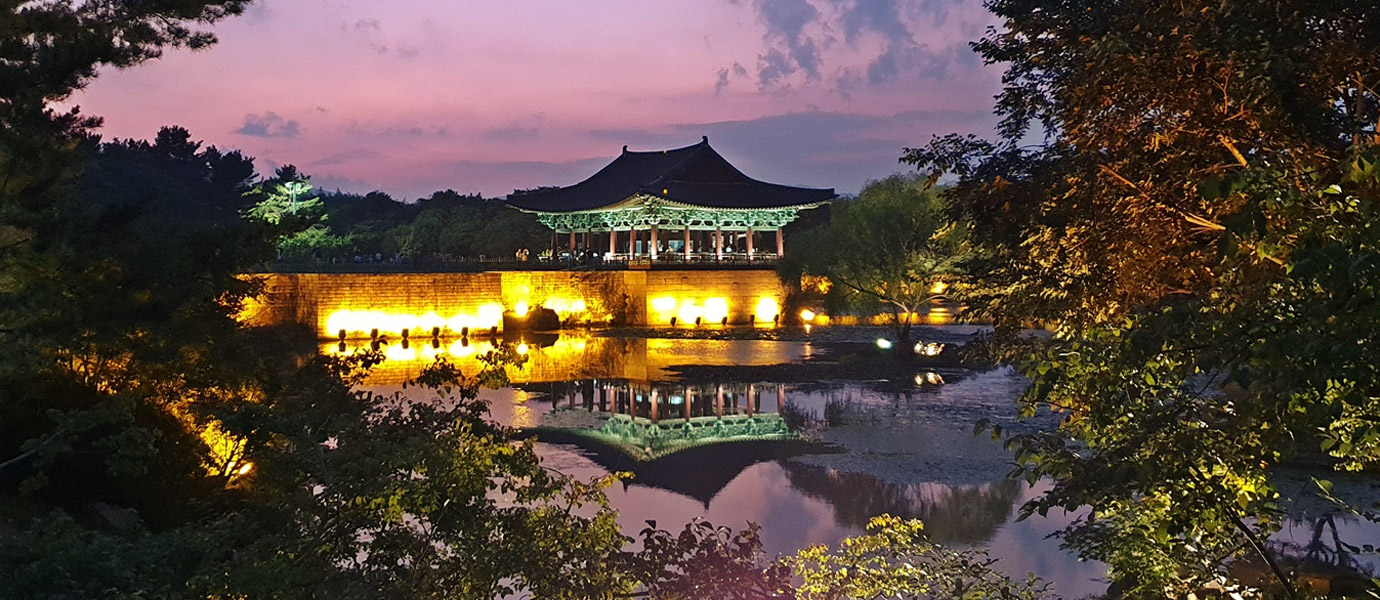
When the sun sets, people flock to capture the night view of Donggung Palace and Wolji Pond. When you enter the grounds, you pass by the three restored buildings in order and head to the back. Follow the path around Wolji Pond and follow where people walk. If you see people gathered in one place, that's it. This is the best spot to capture the night view of Donggung Palace and Wolji Pond. It was the site of the separate palace where the crown prince of the Unified Silla period resided, and it was also used as a banquet hall when there was national celebration. It may be more familiar as Anapji Pond, but it was renamed to its original name in 2011. The time after sunset, when the pond Wolji Pond and the restored buildings are illuminated, is the time to travel back in time to the splendid Silla of a thousand years ago.
- Donggung Palace and Wolji Pond Visiting Information
- Location: 102 Wonhwa-ro, Gyeongju-si, Gyeongsangbuk-do
- Opening hours: 09:00-22:00 (ticket sales close at 21:30)
- Admission Fee: Adults 3,000 won / Teenagers 2,000 won / Children 1,000 won
- Night view lighting lighting time: After sunset ~ 22:00
#2Cheomseongdae
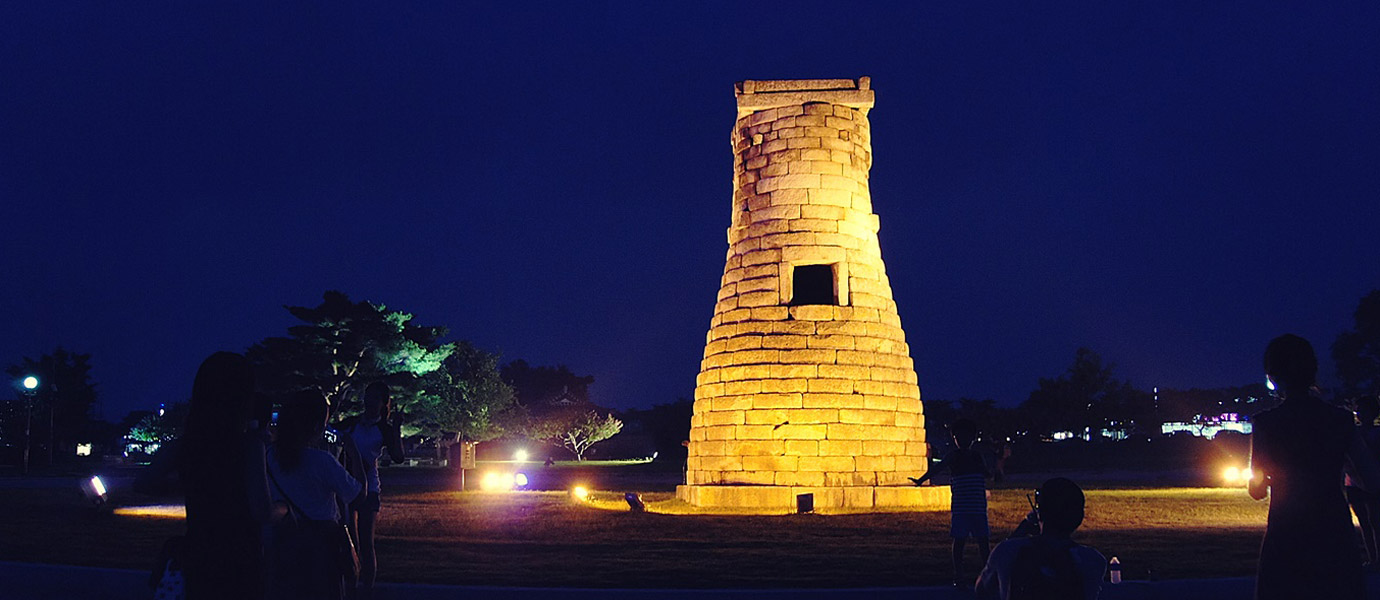
At night in Silla, observers climbed up the Cheomseongdae Observatory by hanging a ladder on the window in the center of the observatory. They observed the movements of the sun, moon, and stars, used them to manage farming, and predicted the fortunes of the country. The oldest astronomical observatory in the East, Cheomseongdae, is located on the plain in front of Wolseong. Since there would have been no streetlights or commercial lights like there are now, it would have been the best place to watch the stars in the open space and pitch-black darkness. Cheomseongdae embodies the movements of the sky. The shape of Cheomseongdae, round at the top and square at the bottom, symbolizes the sky and the earth. The 365 or so stones that make up Cheomseongdae symbolize the number of days in a year, and the 29 and 30 tiers, including the stone steps and the top stone, represent the number of days in a lunar month. The 12 tiers above and below the center window symbolize the 12 months of the year and the 24 solar terms. Today, our history is contained in Cheomseongdae, which has been in the same place for 1,500 years and has engraved the history of Silla.
- Cheomseongdae viewing information
- Location: 839-1 Inwang-dong, Gyeongju-si, Gyeongsangbuk-do
- Opening hours: 09:00 – 22:00 (until 21:00 in winter), open all year round
- Admission: Free
- Night view lighting lighting time: After sunset ~ 22:00
#3Woljeonggyo Bridge
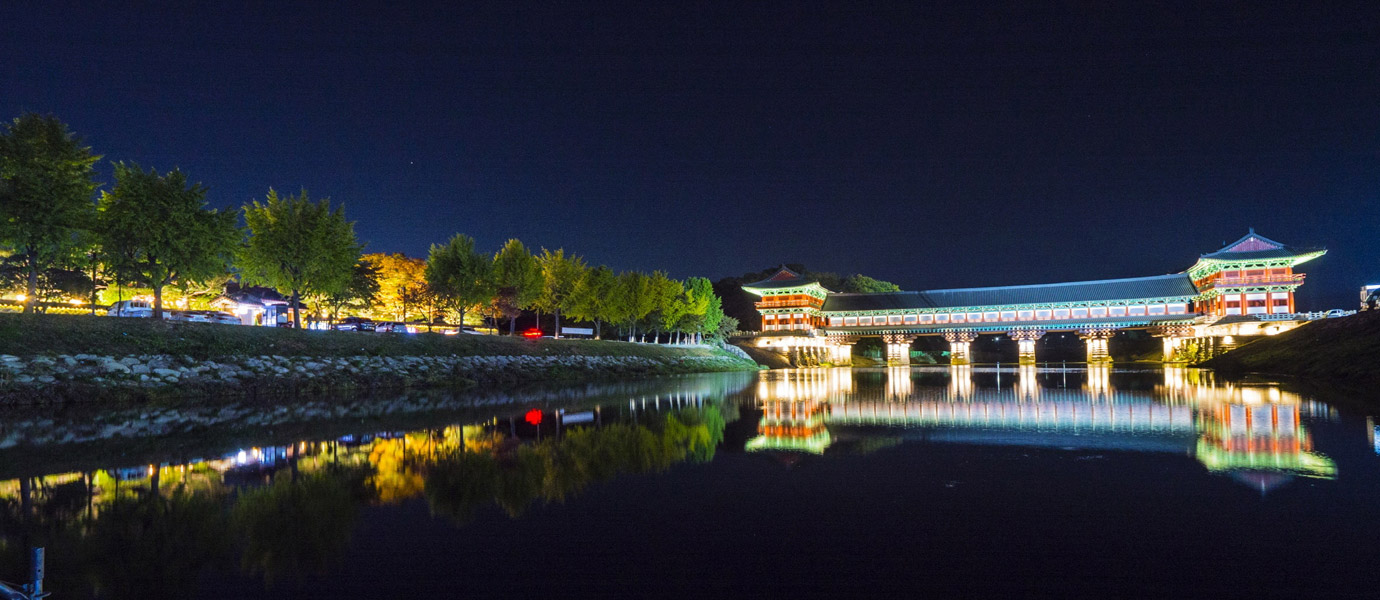
After 10 years of restoration work, Woljeonggyo Bridge was opened to the public in 2018. It is a beautiful wooden bridge over Namcheon (Muncheon), and during the Silla Dynasty, it was the gateway connecting Wolseong, the royal palace, and the southern part of Seorabeol. Now, it is a famous night view spot that connects Gyeongju from one night to the next. Let’s cross the stepping stones installed in front of Woljeonggyo Bridge. You should be careful not to lose sight of Woljeonggyo Bridge shining softly on the river. The inside of the bridge is open to the public until 10 PM, so you can walk around inside the bridge. After enjoying the night view, let’s go to the gatehouse exhibition hall on the second floor to learn about the restoration process of Woljeonggyo Bridge and the excavated artifacts.
- Woljeonggyo Bridge viewing information
- Location: 274 Gyodong, Gyeongju
- Opening hours: 09:00-22:00 (Gateway Exhibition Hall opens at 10:00)
- Admission: Free
- Night view lighting lighting time: After sunset ~ 22:00
#4Gyeongju Eupseong Fortress
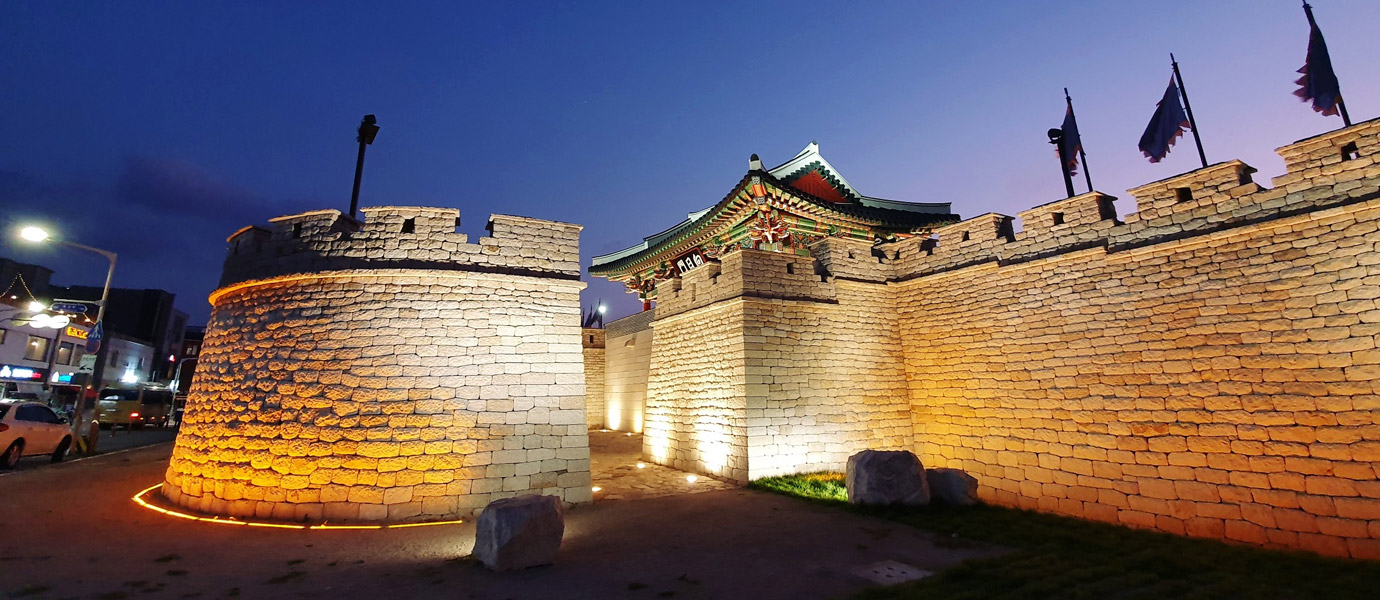
In the center of Gyeongju City, there is Gyeongju Eupseong, which has recently emerged as a new night view spot. If Wolseong and its surrounding area were the center of Silla for a thousand years, the history of the thousand years after Silla was built around Gyeongju Eupseong. During the Joseon Dynasty, the perimeter of the castle was over 2km, and there were entrances and exits in the east, west, south, and north, but today, it is difficult to find traces of them, and only about 100m of the east wall remains. The restoration of Gyeongju Eupseong began in order to shed new light on the thousand-year history of Gyeongju since Silla and to utilize it as a tourist attraction in the Gyeongju city area. The remaining east wall was rebuilt, the east gate, Hyangilmun, was built, and LED landscape lighting was installed. The first restoration was completed in November 2018. It is said that the restoration of the remaining east wall, the north wall, and the north gate, Gongsinmun, is planned, so the night view of the castle will become more beautiful as the years go by.
- Gyeongju Eupseong Fortress Visiting Information
- Location: 31 Dongmun-ro, Gyeongju-si
- Viewing hours: No set times
- Admission: Free
- Night lighting lighting time: After sunset ~ before sunrise the next day
#5Bonghwangdae & Bonghwangro Cultural Street
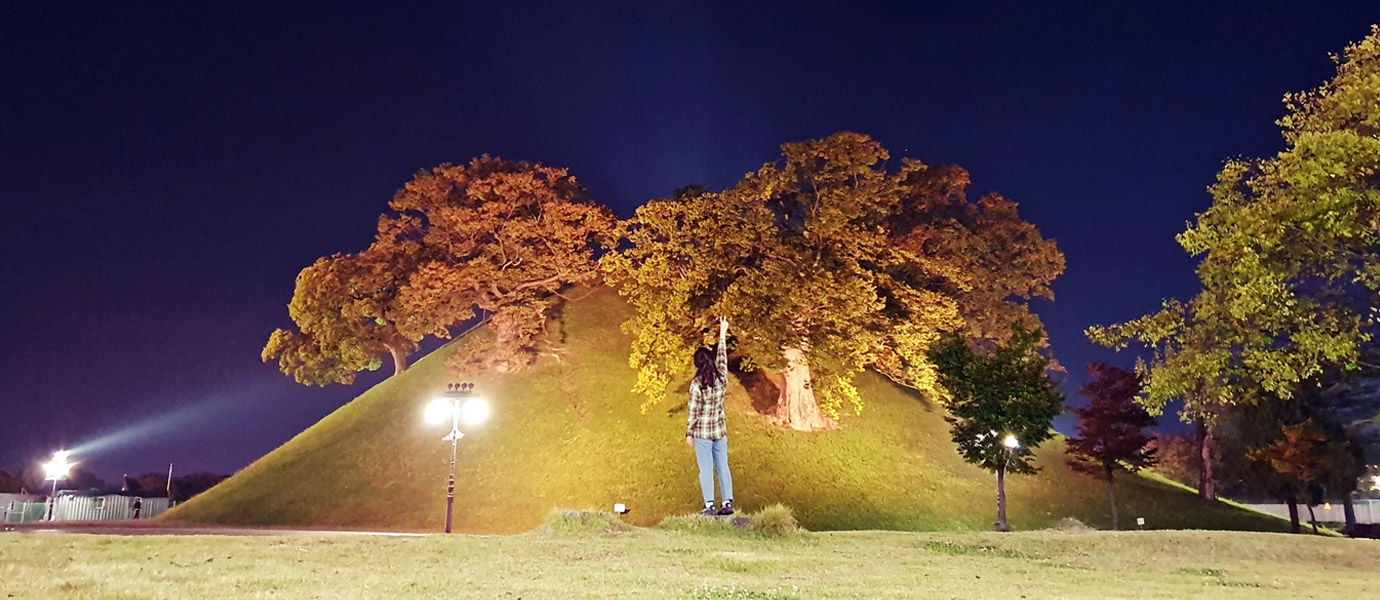
To the north of Daereungwon, there are the Nodong-ri and Noseo-ri Tombs. Among them, the Nodong-ri Tombs stand tall with a huge tomb called 'Bongwhangdae'. It is the largest single tomb, and the unique appearance of many old trees growing on the slope of the tomb is amazing. It is known as a famous night view photo spot with the added landscape lighting. After taking a night view of Bonghwangdae, let's head to 'Bongwhang-ro', a road that naturally connects to Bonghwangdae. The road that runs through Gyeongju City from Naenam Intersection where Hwangridan-gil begins to the Gyeongju Courthouse across from it is called 'Bongwhang-ro Cultural Street'. Recently, luminary landscape lighting was installed on the 500m-long Bonghwang-ro Cultural Street with the theme of 'Smile of a Thousand Years, Light of a Thousand Years'. It is decorated with colorful lighting using icons of Gyeongju such as gold crowns and face-patterned water curtains.
- Bonghwangdae viewing information
- Location: 261 Nodong-dong, Gyeongju-si
- Viewing hours: No set times
- Admission: Free
- Note: 2 minutes walk from Bonghwangdae to Bonghwangro Cultural Street Luminarie
- Night view lighting lighting time: After sunset ~ 22:00
#6Bomunhoban-gil & Bomunjeong
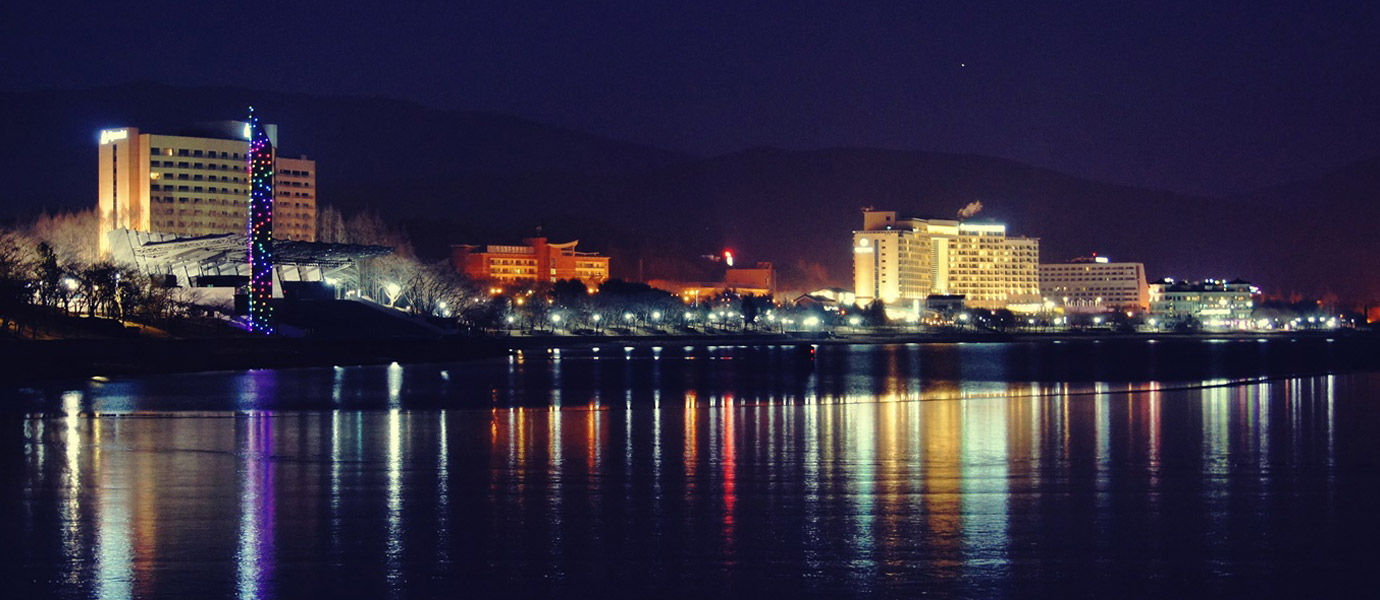
Take a walk along the charming lakeside at night. Bomun Tourist Complex, a comprehensive tourist resort with luxury hotels, resorts, condos, and tourist facilities, has a huge artificial lake of about 500,000 pyeong, Bomun Lake. There is a 'Bomun Lakeside Road' that you can walk around Bomun Lake, and it is a great place to walk at night because it has nighttime lighting installed. You can walk around the 7km section, or you can choose a specific section and take a short walk. In particular, every spring, cherry blossom trees that are over 30 years old bloom, creating a beautiful cherry blossom road. Spring days and nights. It offers an unforgettable nighttime walk along Bomun Lakeside Road. If you go to the other side of the lake through the underground passage from the side where the Uyang Art Museum and Hilton Hotel are located, you will reach Bomun Pavilion with a small pond and pavilion. It is beautiful not only during the day but also at night.
- Information on using Bomunhoban-gil and Bomunjeong
- Bomunhoban-gil Location: 424-33 Bomun-ro, Gyeongju-si (Bomunhoban Square)
- Bomunjeong Location: 150-1, Sinpyeong-dong, Gyeongju-si
- How to get there by public transportation: Take bus number 10 and get off at Gyeongsangbuk-do Cultural Tourism Organization, Bomun Complex stop.
- Night view lighting lighting time: After sunset ~ 23:00 (lights off time may vary depending on the season)
#7Seo Chul-ji
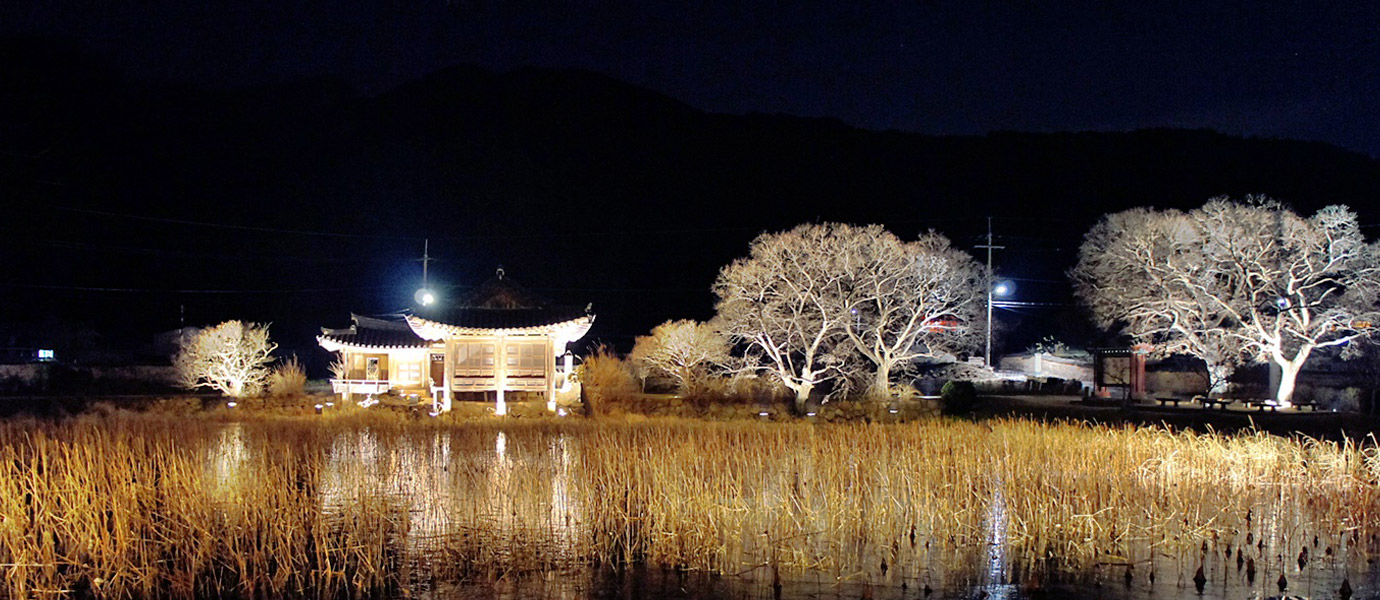
Seochulji Pond, surrounded by Dongnamsan Mountain in Gyeongju like a folding screen. It is located right next to Tongiljeon. The name Seochulji comes from the fact that "the writings (서:書) that benefit the country (출:出 ) came out (날출:出 ) from the pond (목:池)." There is a story in Samguk Yusa that tells about the name. King Soji, the 21st king of Silla, visited Dongnamsan Mountain and met an old man coming out of the middle of the pond. The old man handed him an envelope containing a letter, and the letter contained the words, "Shoot the zither case." The king, who thought this was unusual, returned to the palace and shot the zither case with an arrow, but inside was an assassin who was trying to kill the king. The king saved his life with the letter from the pond, and from then on, the pond was called Seochulji Pond. Every summer, Seochulji Pond is adorned with lotus flowers and crape myrtle trees, creating a beautiful scenery. The trees surrounding the pond and the pavilion, Iyodang, are equipped with night-view lighting, making it a famous night view spot.
- Seochoji viewing information
- Location: 17 Namsan 1-gil, Gyeongju-si
- Viewing hours: No set times
- Admission: Free
- How to get there by public transportation: Take bus number 11 and get off at Tongiljeon stop
- Night view lighting lighting time: After sunset ~ 22:00
#8Golden pedestal
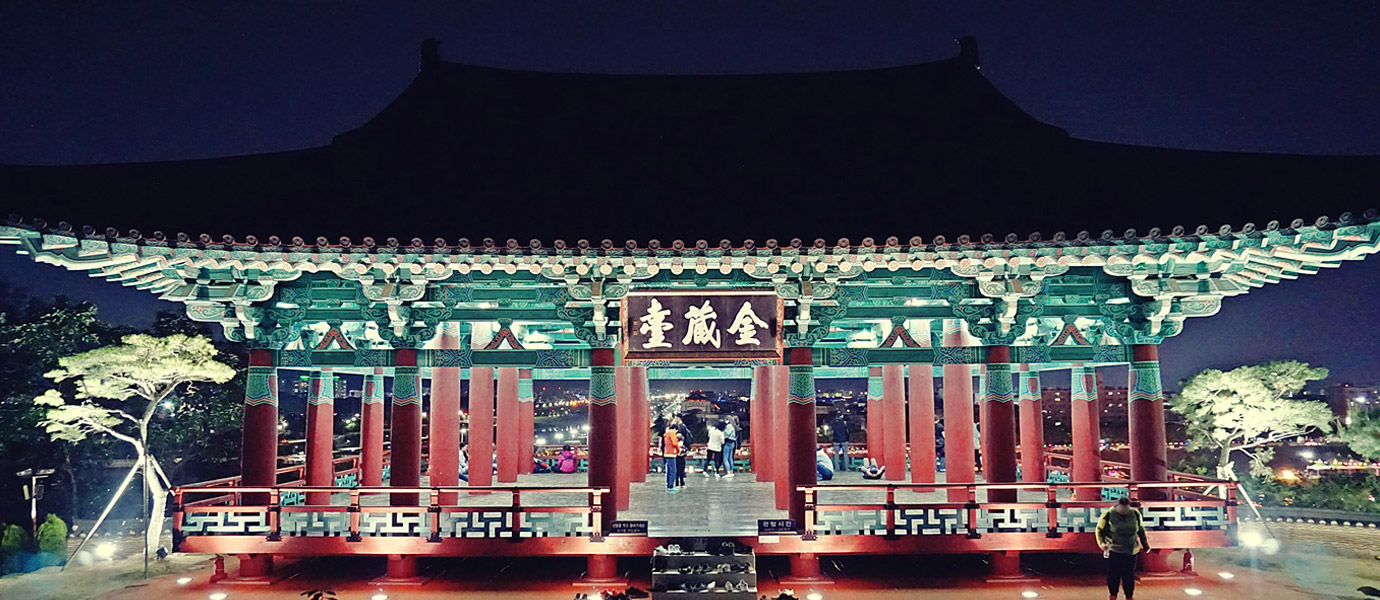
Let's take a picture of the night view of Gyeongju city from Geumjangdae, a pavilion boasting such an outstanding view that it is said that geese passing by Hyeongsan River stopped by because they were captivated by the beautiful scenery. Gyeongju has a story about the "Samgi Palgoe", which refers to three rare treasures and eight strange phenomena. Among the eight strange phenomena, the "Geumjangnakan (金丈落雁)" is a story about geese stopping by after being captivated by the scenery seen from Geumjangdae above Yegicheon River where Seocheon and Bukcheon meet. Geumjangdae is a pavilion on a rock that was rebuilt and opened in 2012. The pavilion is equipped with night-time lighting, and from the pavilion, you can see the Hyeongsan River and the night view of Gyeongju city at a glance.
- Geumjangdae viewing information
- Location: 38-9 San, Seokjang-dong, Gyeongju-si
- Opening hours: 06:00-22:00
- Admission: Free
- How to get there by public transportation: Take bus number 40 and get off at Dongguk University Hospital stop
- Night view lighting lighting time: After sunset ~ 22:00
#9Gamsansa Temple
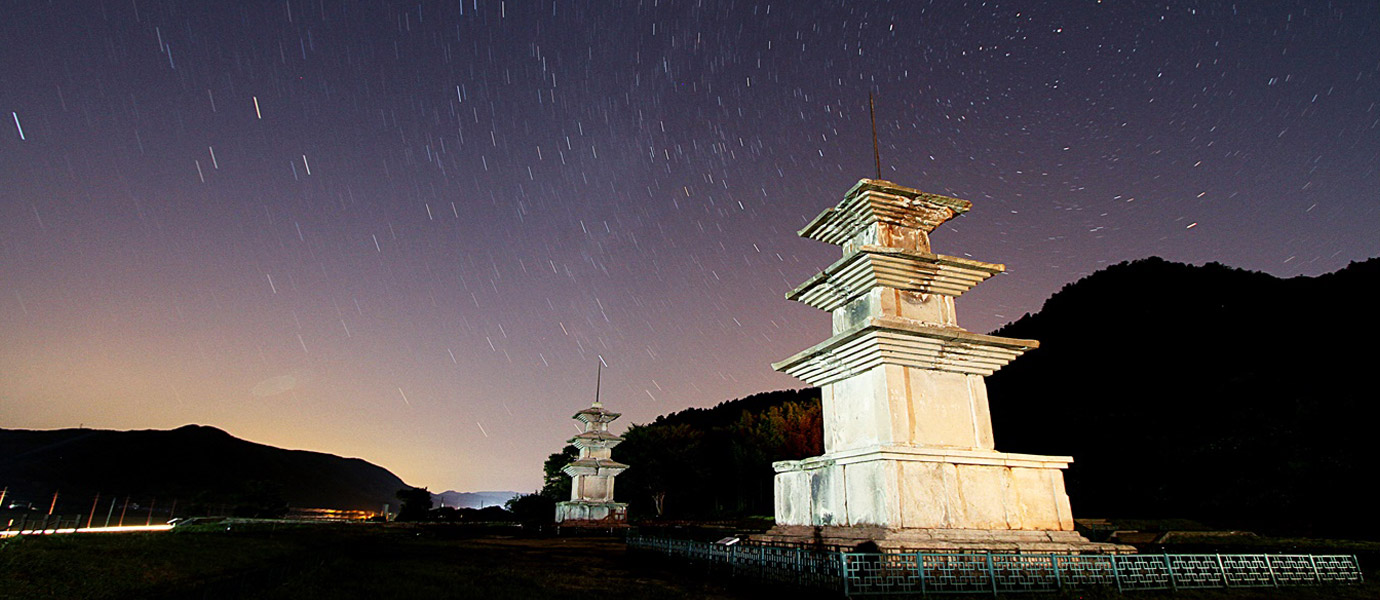
Source: Gamsansa Temple Night View Kim Hak-su (6th Gyeongju City Tourism Photo Exhibition)
Gamsansa Temple was built by King Sinmun for his father, King Munmu. King Munmu, who started building the temple as a national defense temple to prevent the invasion of Japanese pirates, passed away a year later, so King Sinmun took over and completed it. You can see the site of Geumdang, which was the building site, and in front of it, the East and West Three-story Stone Pagodas of the Gameunsa Temple Site stand proudly. The two huge pagodas, which are as tall as three stories of an apartment building, are typical of the temple layout that started with a single pagoda in the Silla period and continued to form a pair of pagodas during the Unified Silla period. At night, the East and West Three-story Stone Pagodas are illuminated with landscape lighting. Since the surrounding area is relatively dark, many photographers visit to capture the night sky and the stone pagodas together.
- Gamsasa Temple Visiting Information
- Location: 1248 Donghaean-ro, Gyeongju-si
- Opening hours: No set times (Cultural tourism commentary hours 10:10-16:30, peak season until 17:00)
- Admission: Free
- How to get there by public transportation: Take bus number 150 and get off at Top Village/Gamunsaji stop
- Night view lighting lighting time: After sunset ~ 22:00
#10Gyeongju Expo Park Gyeongju Tower & Lumina Night Walk
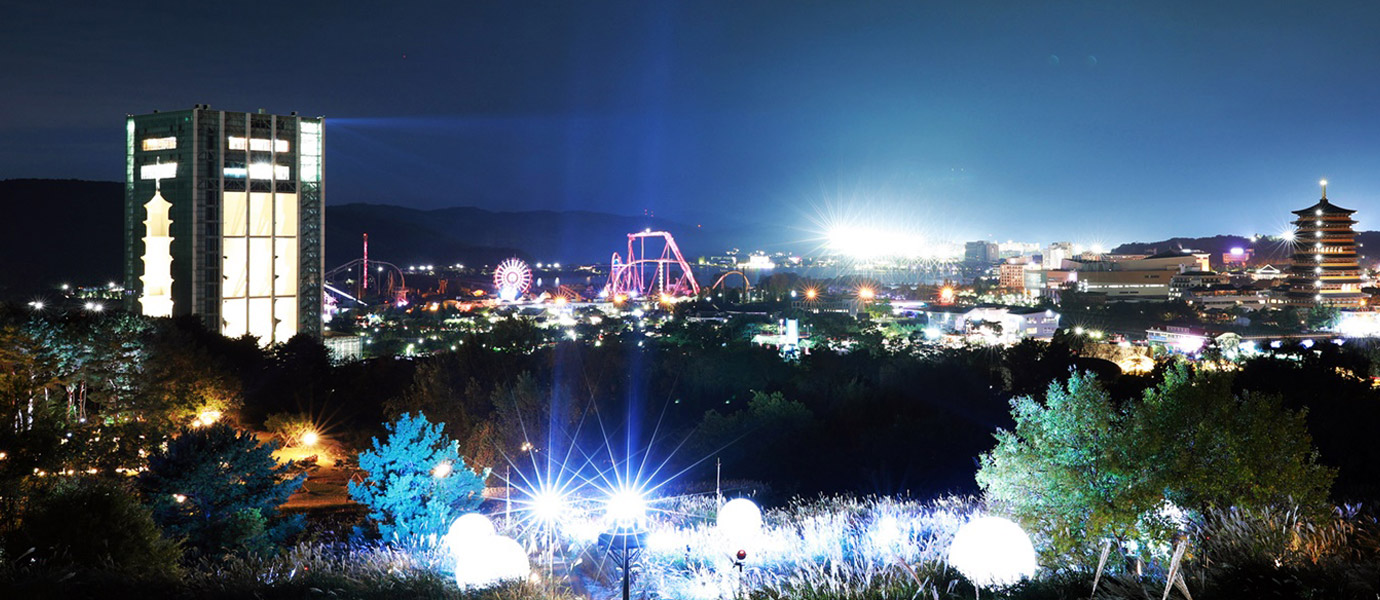
Source: Gyeongju Expo Park Lumina Night Walk (provided by Gyeongju World Culture Expo)
The Gyeongju World Culture Expo Park, where you can experience, exhibit, perform, and relax in one space, is introducing a new nighttime attraction. Most of the exhibition halls, art galleries, and experience halls in the park are open until 6 PM, but the park is open until 10 PM, so you can enjoy new nighttime content and stroll around the park at night. The 'Lumina Night Walk, a star containing Silla' attraction, which was one of the contents of the '2019 Gyeongju World Culture Expo' event, will be operated permanently. A path of light with holograms and various lights unfolds along the observation deck on the hill behind Gyeongju Tower. The 'Gyeongju Tower' observatory, which is an engraved image of the nine-story wooden pagoda of Hwangnyongsa Temple, is also beautifully lit up at night.
- Gyeongju Expo Park Visiting Information
- Location: 614 Gyeonggam-ro, Gyeongju-si
- Opening hours: 10:00-22:00 (Exhibitions and experience centers open until 18:00) / Lumina Night Walk 17:00-22:00 (Ticket sales close at 21:00)
- Admission Fee: Integrated admission fee for adults 8,000 won (applicable until 12/31/19) / Lumina Night Walk for adults 5,000 won (including park admission fee after 17:00)
- How to get there by public transportation: Take bus number 0, 100, or 150 and get off at Gyeongju World Culture Expo Park stop.
- Night view lighting lighting time: After sunset ~ 22:00
- Photo credit: Park Tae-yoon Gyeongju Tower (provided by Gyeongbuk Culture and Tourism Organization)
Knowledge Filling 10 Picks
- How to travel Gyeongju one step deeper, chew, tear, taste, and enjoy the various museums and exhibition halls in Gyeongju. You can dig deep in a museum that covers the thousand-year history of Silla, and enjoy the pleasure of learning stories you didn't know about in an exhibition hall that focuses on a single theme. Gyeongju, which served as the capital from the beginning of Silla to the end, has as many themes to unfold as its accumulated history. Here are 10 museums and exhibition halls in Gyeongju.
#1National Gyeongju Museum
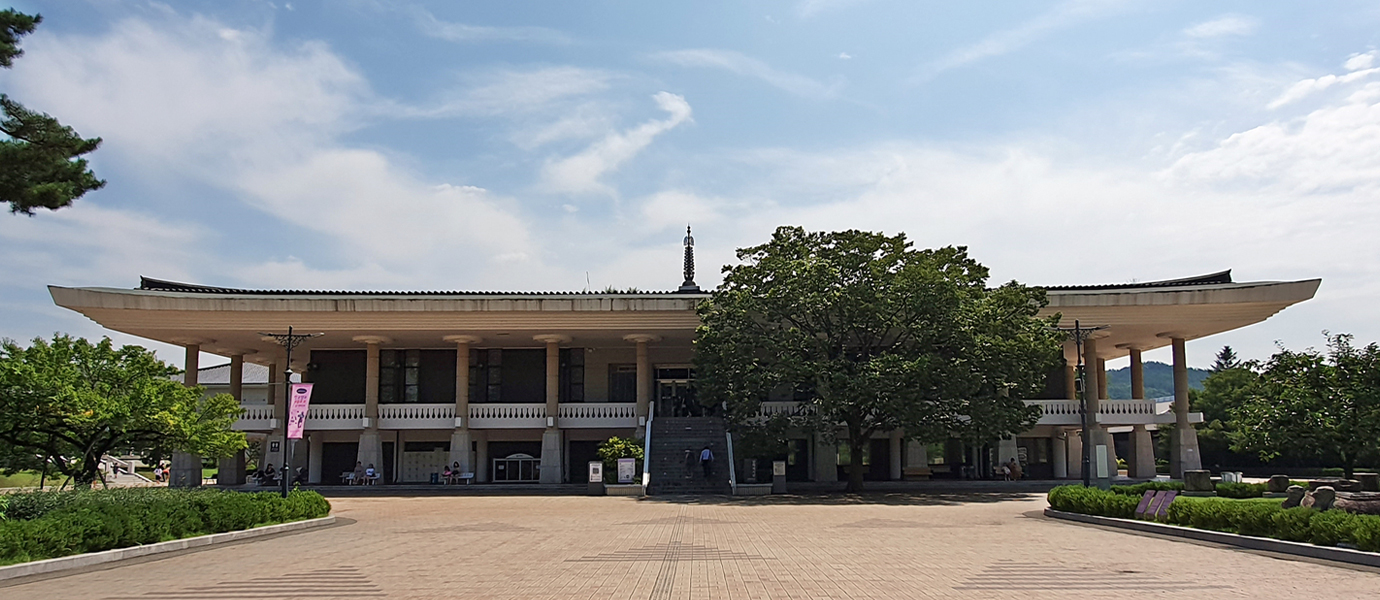
At the National Gyeongju Museum, you can see the compressed history of Silla for a thousand years. If you visit Gyeongju as your first destination and study in advance and see the cultural heritages here and there, you will have a fulfilling trip. The museum is largely composed of three permanent exhibition halls, including the Silla History Hall, the Silla Art Hall, and the Wolji Hall, as well as a special exhibition hall where special exhibitions are held.
The Silla History Museum displays the history of Silla from its foundation to its fall in four rooms. If you want to learn about the high-quality Buddhist art of Silla, head to the Silla Art Museum. The Wolji Hall is an exhibition hall that organizes excavated artifacts based on excavations of Donggung and Wolji. You can see precious artifacts such as restoration models of Donggung and Wolji, wooden boats excavated from Wolji, and a gilt-bronze seated Buddha triad. The three permanent exhibition halls operate exhibition commentary programs at set times, so it is a good idea to check the schedule before visiting the museum and listen to the commentary while viewing the exhibition halls.
There is one more point that you should not miss at the National Exhibition Hall. There are national treasures in the museum yard. While looking around the outdoor exhibition hall, you can see precious relics such as the King Seongdeok's Divine Bell and the Three-story Stone Pagoda of Goseonsa Temple.
The Yeongnam Regional Archives opened right next to the National Gyeongju Museum in May of this year (2019). This is an archive built to systematically store over 600,000 buried cultural assets excavated from the Yeongnam region. You can visit the exhibition archives that display over 3,000 major relics such as Silla pottery and roof tiles, as well as the lobby exhibition hall where you can learn about the excavation, preservation, and restoration of cultural assets.
- National Gyeongju Museum Visiting Information
- Location: 186 Iljeong-ro, Gyeongju-si, Gyeongsangbuk-do
- Viewing hours:
This table shows the National Gyeongju Museum's opening hours by day, period, and time (opening, closing). Day of the week period hour survey Closed Weekdays (Mon-Fri) All year round 10 o'clock 6 o'clock Culture Day
(Last Wednesday of every month)10 o'clock 21:00 Saturday January-February 10 o'clock 7 o'clock March - December 10 o'clock 21:00 Sundays and public holidays All year round 10 o'clock 7 o'clock - Closed: January 1st, Lunar New Year and Chuseok
- Admission: Free
- For inquiries: 054 740 7500
- Website: http://gyeongju.museum.go.kr/
- How to get there by public transportation: Take bus no. 10, 700, or 11 / Get off at Folk Craft Village stop
- Nearby tourist attractions: Bulguksa Temple, Seokguram Grotto, Bomun Tourist Complex
#2Silla History and Science Museum
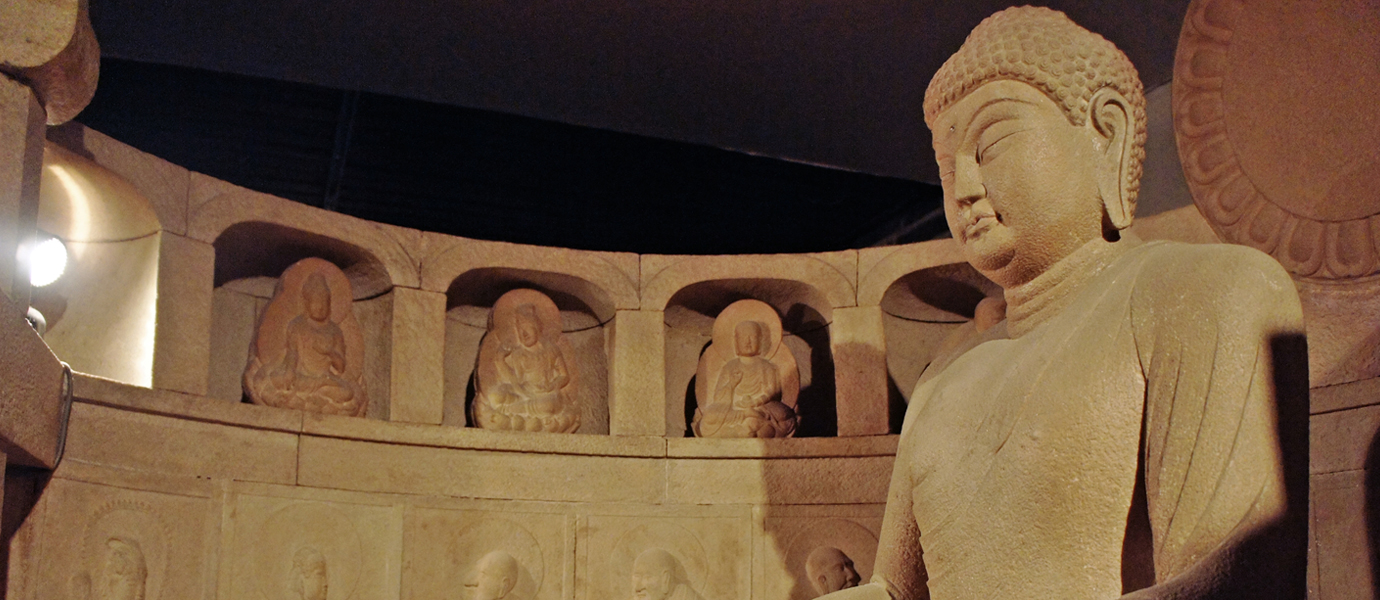
The Silla History and Science Museum, which is called the second Seokguram, is located in the Folk Craft Village. It is a place that you must visit before visiting Seokguram. In order to protect cultural assets, a glass wall has been installed, so we cannot see the inside of Seokguram except on Buddha's Birthday. The beauty of the main Buddha, which is called the essence of Silla Buddhist art, shines even through the glass window, but it is regrettable that we cannot look around the inside of the scientifically constructed stone cave. It is known that the director of the Silla History and Science Museum, who was very sorry about the main Buddha of Seokguram, which was fighting a war with moss and moisture due to the wrong restoration by the Japanese, used his personal funds to collect research materials about Seokguram and organize the exhibition.
At the Shilla History and Science Museum, you can take a close look at the cultural heritages that are the products of our ancestors’ amazing science and technology and architectural techniques. The main exhibition contents are the models of Cheomseongdae and Seokguram Grotto. A 1/10 Cheomseongdae model, where you can study the structure of Cheomseongdae, which has remained in place for 1,500 years without collapsing or shaking, is located in the first-floor exhibition hall. The underground exhibition hall, led by the 1/5 Seokguram model, displays Seokguram Grotto as if it were an anatomy of the inside, allowing you to examine the exquisitely built and detailed carvings of Seokguram Grotto. To understand the exhibitions more richly, try the permanent commentary program held every weekend at 10:00 AM and 2:00 PM. You can hear detailed explanations that you cannot understand just by looking at them. In addition to the models of Cheomseongdae and Seokguram Grotto, you can encounter a variety of scientific and beautiful cultural heritages of our ancestors that are surprising the more you look.
- Information on the Shilla History and Science Museum
- Location: 33 Hadong Craft Village Road, Gyeongju
- Opening hours: 09:00-17:00
- Closed: Every Monday
- Admission Fee: Adults 5,000 won / Students 3,500 won
- For enquiries: 054 745 4998
- Website: http://www.sasm.or.kr/
- How to get there by public transportation: Take bus no. 10, 700, or 11 / Get off at Folk Craft Village stop
- Nearby tourist attractions: Bulguksa Temple, Seokguram Grotto, Bomun Tourist Complex
#3Hwarang Village
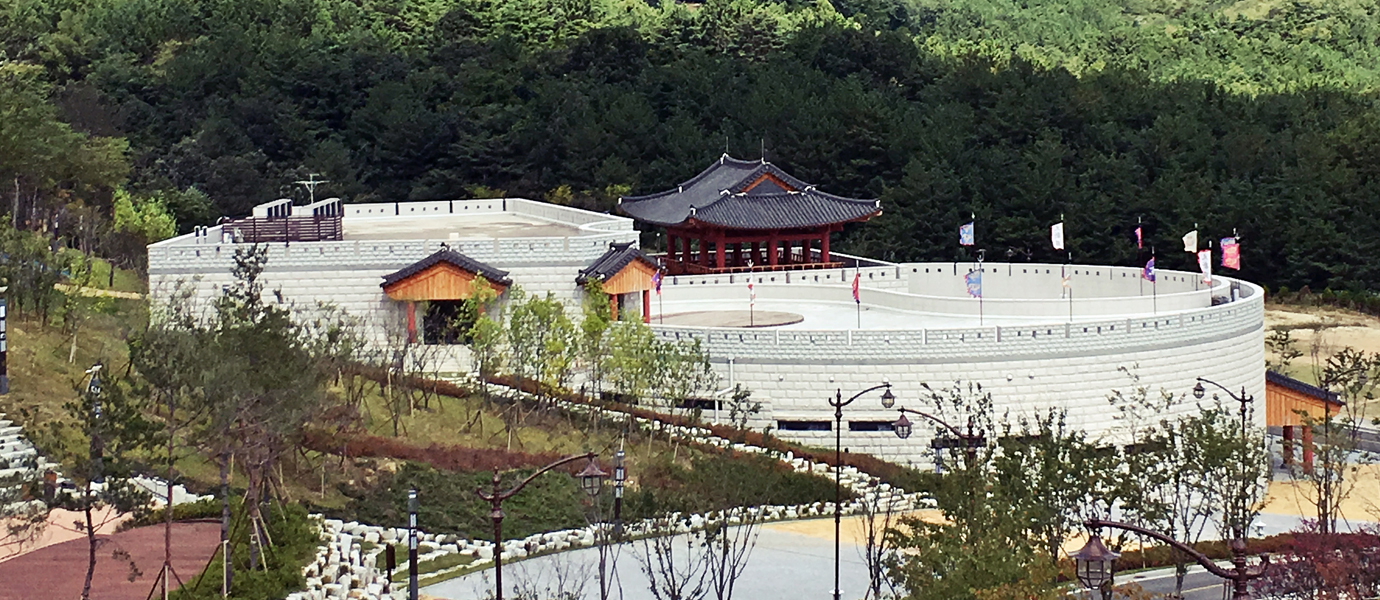
The Hwarang of the Silla Dynasty came to today's Gyeongju. The spirit of patriotism that created the first unified nation on the Korean Peninsula, the culture that blossomed when Hwarang and Nando groups came together, and to shed new light on the spirit and value of Hwarang, the 'Hwarang Village' was created in Seokjang-dong, Gyeongju. It was created as part of the three major cultural zone core leading projects of the Ministry of Culture, Sports and Tourism. It is positioned as a complex cultural space where education, experience, relaxation and tourism are all possible. On a site of approximately 100,000 pyeong at the foot of Songhwasan Mountain in Seokjang-dong, there are beautiful Hanok buildings such as exhibition halls, education centers, living centers, and meditation centers, as well as an outdoor cultural experience space such as an Eoulmadang, an outdoor performance hall, a martial arts experience center, an archery range, and an activity experience center.
The main exhibition hall of Hwarang Village catches the eye with its unique architectural design modeled after the Silla fortress. The exhibition content is organized along the footsteps of Hwarang in Silla history, from the beginning of Hwarang. There is a model exhibition of the Imsinseogiseok, which is inscribed with the Hwarang’s oath and spirit, experiential content where you can learn through play such as Jureunggu, Silla musical instruments, and Cheoyongmu, and a space to experience Hwarang costumes, etc., along the viewing route.
Below the Eoulmadang (grass field) is another exhibition hall, the ‘Sanginam Exhibition Hall’. The exhibition is based on the story of Kim Yu-sin, with the ‘Sanginam’ stone cave temple at the top of Danseoksan Mountain, where it is said that Kim Yu-sin cut the rock with his sword while practicing, as the background. After viewing the exhibition hall, let’s walk along the beautiful walking path in Hwarang Village and follow in the footsteps of the Hwarang who recharged their spirits while walking around the mountains and rivers.
- Hwarang Village Visiting Information
- Location: 123 Seokhyeon-ro, Gyeongju-si
- Opening hours: 09:00-18:00
- Closed: January 1st, Lunar New Year and Chuseok
- Admission: Free
- For inquiries: 054 760 2432
- Homepage: http://www.gyeongju.go.kr/hwarang/
- How to get there by public transportation: Take bus number 40 / Get off at Hwarang Village stop
- Nearby tourist attractions: General Kim Yu-sin's tomb, King Muyeol's tomb, Daereungwon
#4Hwangryongsa Temple History and Culture Museum
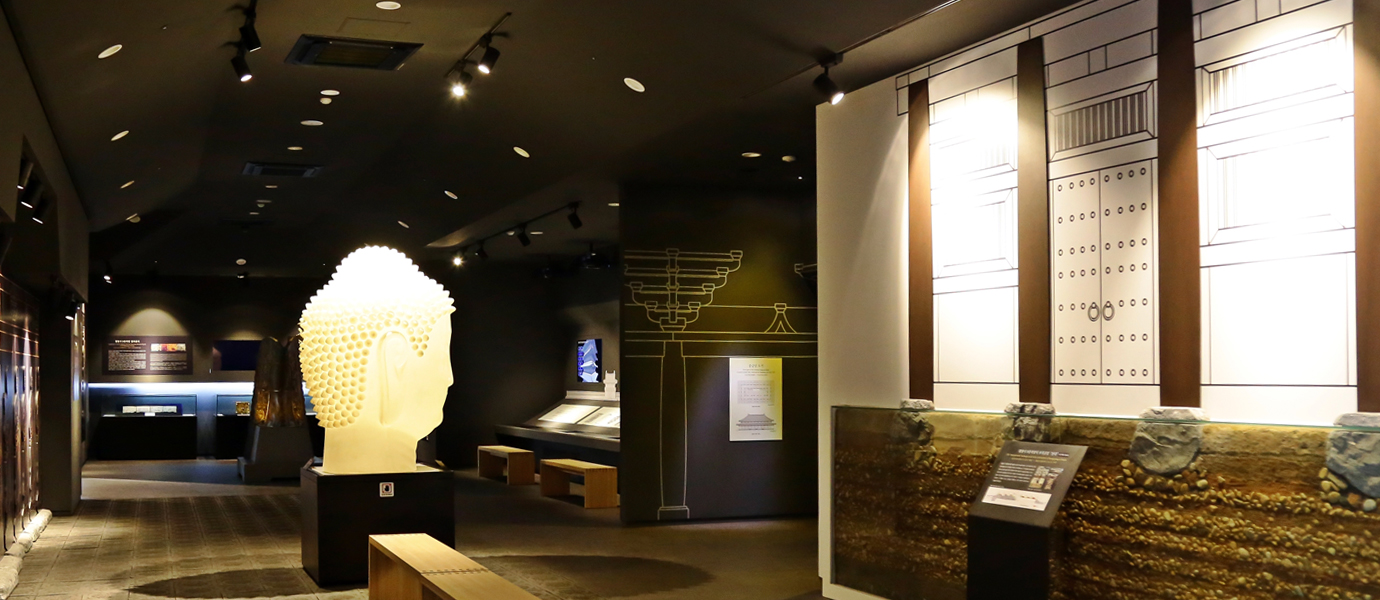
Hwangnyongsa, the national temple and guardian temple of Silla, was a place where Silla’s culture and art were concentrated. The grandeur of Hwangnyongsa, the largest temple in the East that was destroyed by fire during the Goryeo Dynasty, can only be imagined when looking at the vast site. The Hwangnyongsa History and Culture Center opened in 2016 on a 14,000㎡ site adjacent to the Hwangnyongsa site. It was built to share the excavation results and restoration process of the Hwangnyongsa site with everyone. It has a 3D stereoscopic video room that shows the process of Hwangnyongsa from its construction to its destruction, as well as a Silla History Exhibition Hall that displays excavated artifacts. The highlight of the Hwangnyongsa History and Culture Center is the 1/10 scale model of the Hwangnyongsa Nine-story Wooden Pagoda in the wooden pagoda exhibition hall on the first floor. I wonder how they built the wooden pagoda that is over 80 meters tall, and I feel a mixture of respect and curiosity. Let’s get a sense of the overwhelming grandeur of Hwangnyongsa during its time at the Hwangnyongsa History and Culture Center.
- Hwangryongsa History and Culture Museum Visiting Information
- Location: 64-19 Imhae-ro, Gyeongju-si
- Opening hours: 09:00-18:00
- Closed: January 1st, Lunar New Year and Chuseok
- Admission Fee: Adults 3,000 won / Youth/Military 2,000 won / Children 1,500 won
- For inquiries: 054 777 6862
- How to get there by public transportation: Take bus no. 10, 100, 150, or 700 / Get off at Gyeonggi Intersection stop
- Nearby tourist attractions: Bunhwangsa Temple, Donggung Palace, Wolji Pond, and other historic sites in the city
#5Bulguksa Museum
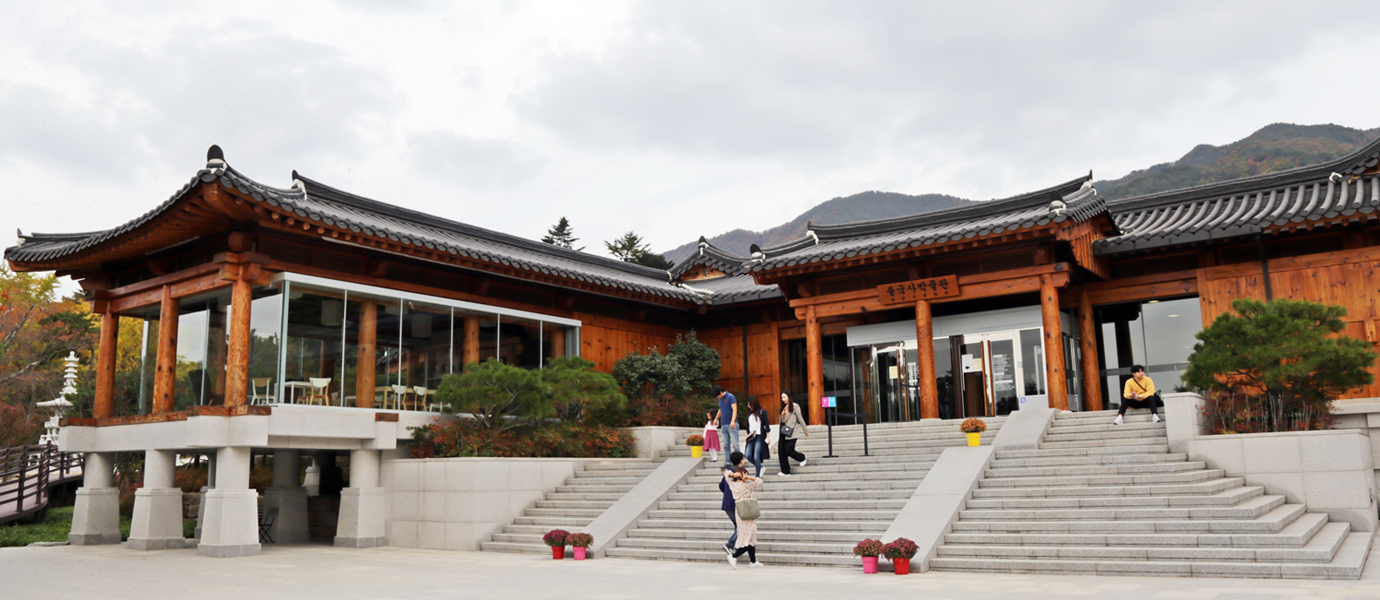
Bulguksa Temple, which is a museum in itself, has added another attraction. The museum construction project that began over 20 years ago has finally come to fruition, and a museum exhibiting Bulguksa Temple’s sacred cultural assets opened in November 2018. It is a Buddhist culture museum where you can see various Buddhist art pieces and donated artifacts from the temple, including the Seokgatap sarira reliquary, which is designated as a national treasure. The museum is built on a 3,500-pyeong site with one underground floor and one above-ground floor. In addition to the exhibition hall, there is a storage room where artifacts are stored, an academic research lab where research is conducted, and a library and reference room.
The exhibition is largely divided into four sections. Starting with the exhibition room that shows the history of Bulguksa Temple in chronological order, the exhibition room where you can see the original Sakyamuni Pagoda Sarira Reliquary, designated as National Treasure No. 126, the exhibition room themed on Buddhist statues and Buddhist paintings, and finally the space that displays artifacts donated to Bulguksa Temple by Haksan Nam Seok-hwan, continues in that order. Let’s take a look at the true face of Buddhist art that blossomed throughout the thousand-year history of Silla.
- Bulguksa Museum Visiting Information
- Location: 385 Bulguk-ro, Gyeongju-si
- Opening hours: 09:00-18:00 (until 17:00 in winter)
- Closed: Every Monday, January 1st, Lunar New Year and Chuseok
- Admission Fee: Adults 2,000 won / Youth and Children 1,000 won (Bulguksa Temple entrance fee separate)
- For inquiries: 054 745 2100
- How to get there by public transportation: Take bus no. 10, 11, or 700 / Get off at Bulguksa stop
- Nearby tourist attractions: Bulguksa Temple, Seokguram Grotto
#6Museum of Korean Popular Music
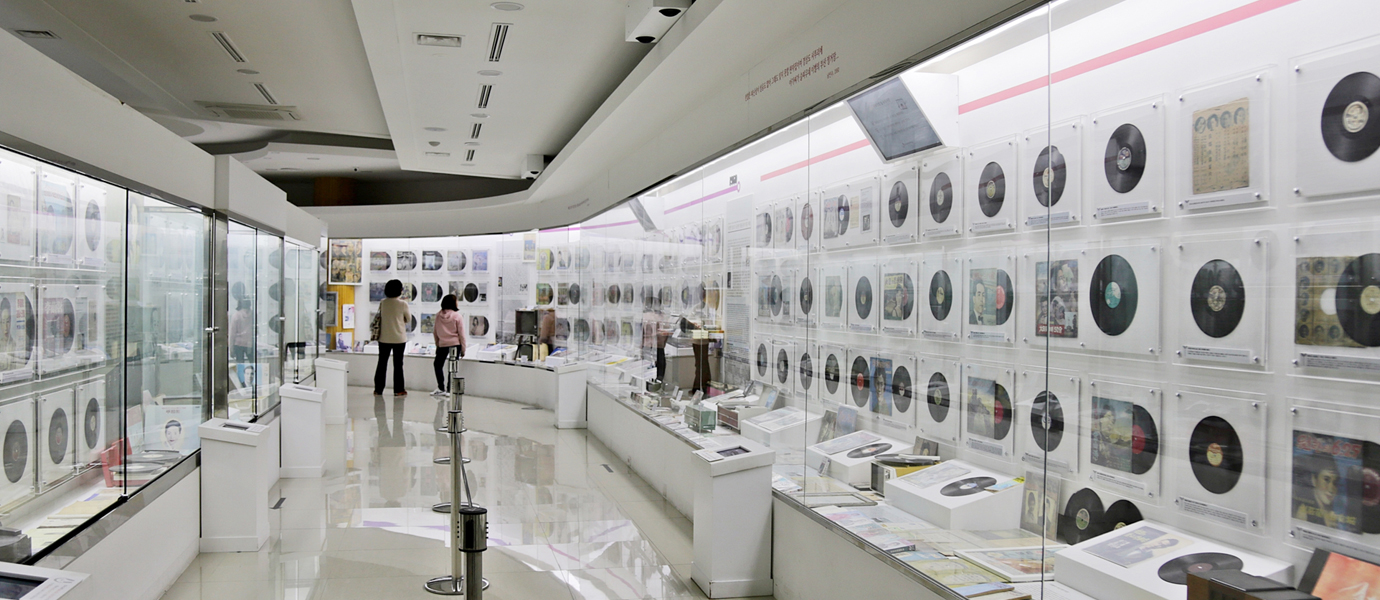
The 'Museum of Korean Popular Music', which covers the history of Korean popular music, is located in Bomun Tourist Complex. It is registered as the only first-class specialized museum in Gyeongju along with the Gyeongju National Museum. The building, which has 1 underground floor and 3 above-ground floors, is filled with music. The tour begins on the 2nd floor, and the main exhibition hall on the 2nd floor organizes the 100-year history of popular music. You can encounter a variety of music, from the first popular songs to trendy recent popular music. There are also headsets provided so you can listen to the records displayed throughout the museum, so come and experience music from various periods and genres.
The third floor is a sound museum that introduces 100 years of audio history. From the speakers introduced by Western Electric in the 1920s to screen the first sound film, to Eurodin, Ampex, Altec, and Tannoy, a variety of rare sound devices from around the world are on display. The final part of the sound museum is a music appreciation room. If you request the music you want, you can listen to it with great sound.
- Information on visiting the Museum of Korean Popular Music
- Location: 9 Expo-ro, Gyeongju-si (Sinpyeong-dong)
- Opening hours: 10:00-18:00 (Last admission at 17:00)
- Closed: Every Monday
- Admission Fee: Adults 12,000 won / Teenagers 9,000 won / Children 6,000 won (40% discount when purchasing in advance)
- For inquiries: 054 776 5502
- Homepage: https://blog.naver.com/kpopmuseum1
- How to get there by public transportation: Take bus no. 10 or 700 / Get off at Hilton Hotel stop
- Nearby tourist attractions: Bomun Tourist Complex, Gyeongju World Culture Expo Park, Gyeongju Donggungwon
#7Yangdong Village Cultural Center
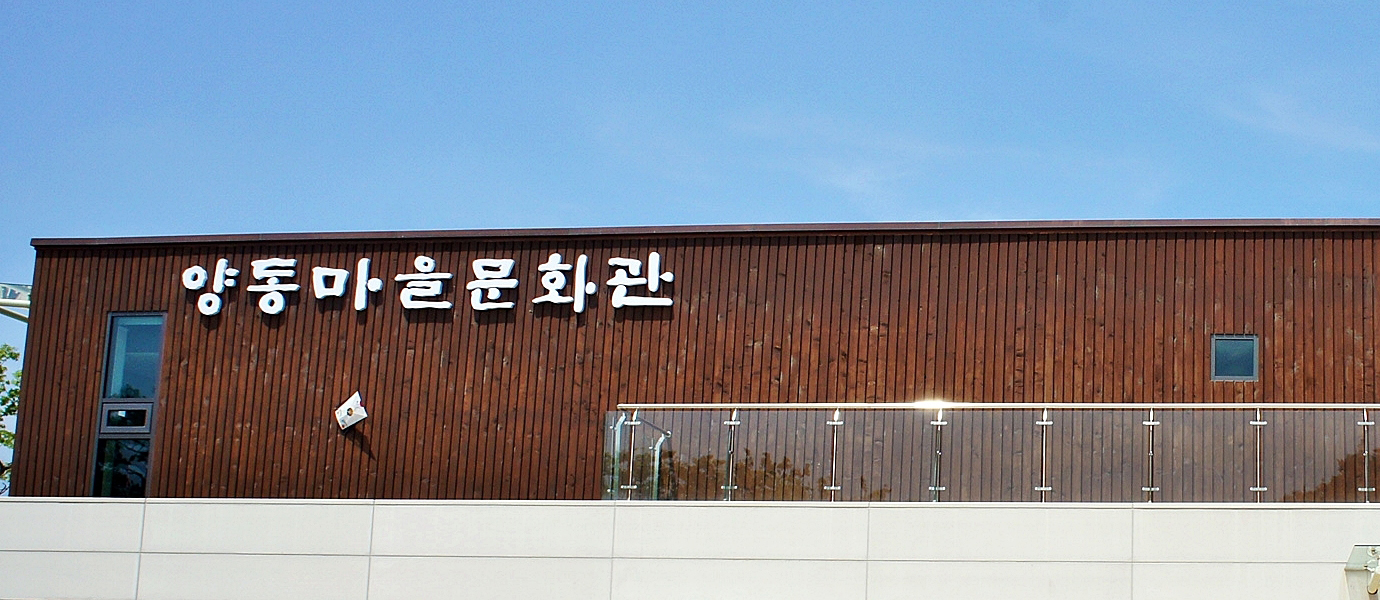
Yangdong Village, where the two clans of Yeogang Lee and Wolseong Son have been pushing and pulling each other for over 500 years, is a historic village that has produced many outstanding talents, including Lee Eon-jeok and Son Jung-don. In 2010, it was registered as a UNESCO World Heritage Site along with Andong Hahoe Village as a “Historic Village of Korea.” The village has a long history, and it has many stories to tell. Starting with the origin of Yangdong Village, it provides a detailed introduction to the cultural heritages it holds. The first floor exhibition hall features content that recreates folk games played in Yangdong Village for generations, and displays and explanations of models of the village’s main old houses. The second floor exhibition hall displays ancient documents, calligraphy, clothing, and books that the clan guards like heirlooms. There is a cultural center before entering the village, so it is recommended to visit the cultural center first and then head to the village.
- Yangdong Village Cultural Center Visiting Information
- Location: 93 Yangdongmaeul-gil, Gangdong-myeon, Gyeongju-si
- Opening hours: 09:00-17:00
- Closed: Every Monday
- Admission: Free
- For enquiries: 054 779 6127
- How to get there by public transportation: Take bus number 203 / Get off at Yangdong Folk Village stop
- Nearby tourist attractions: Yangdong Village, Oksan Seowon, Dokrakdang
#8National Research Institute of Cultural Heritage Cheonjonggo
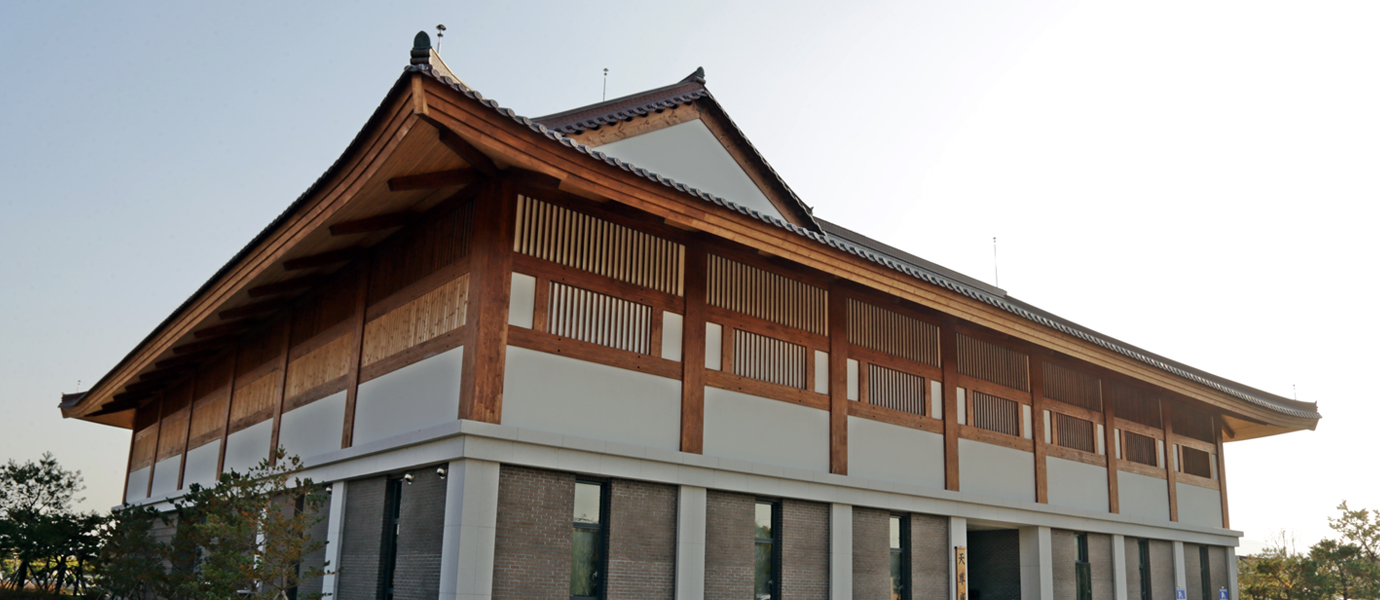
'Cheonjonggo' was the royal treasure house of the Silla Dynasty. According to Samguk Yusa, King Sinmun obtained the flute Manpasikjeok from the East Sea and stored it in Cheonjonggo. The National Research Institute of Cultural Heritage in Gyeongju, which traces the history of Silla based in Gyeongju, opened Cheonjonggo as a storage and exhibition space for its collection of relics in 2018. Cheonjonggo was built as a hanok-style building with one basement floor and three above-ground floors with support from the lottery fund. Inside, it is equipped with four general storage rooms, one special storage room, and one stone storage room to improve the preservation and management environment for excavated relics.
In addition, it has a reading room for the research institute's collection of artifacts and an exhibition room for excavated artifacts. The excavated artifacts exhibition room on the first floor is open to the public. Currently (as of November 2019), the first floor exhibition room is hosting the 'Deokyeopilshin Wanglasabang' exhibition. This exhibition was planned to help understand the development of Silla history and the development of culture. It exhibits around 200 carefully selected artifacts from the Silla period excavated directly by the research institute, and in particular, you can see the 'Pohang Jungseong-ri Silla Stele', the oldest existing Silla stone monument.
- National Research Institute of Cultural Heritage Cheonjonggo viewing information
- Location: 132 Bulguk-ro, Gyeongju-si
- Opening hours: 09:00-18:00 (Lunchtime 11:30-13:00)
- Admission: Free
- For enquiries: 054 777 8847
- How to get there by public transportation: Take bus no. 11 / Get off at Gujeong 2-gu stop
- Nearby tourist attractions: Bulguksa Temple and Seokguram Grotto
#9Traditional Silk Exhibition Hall
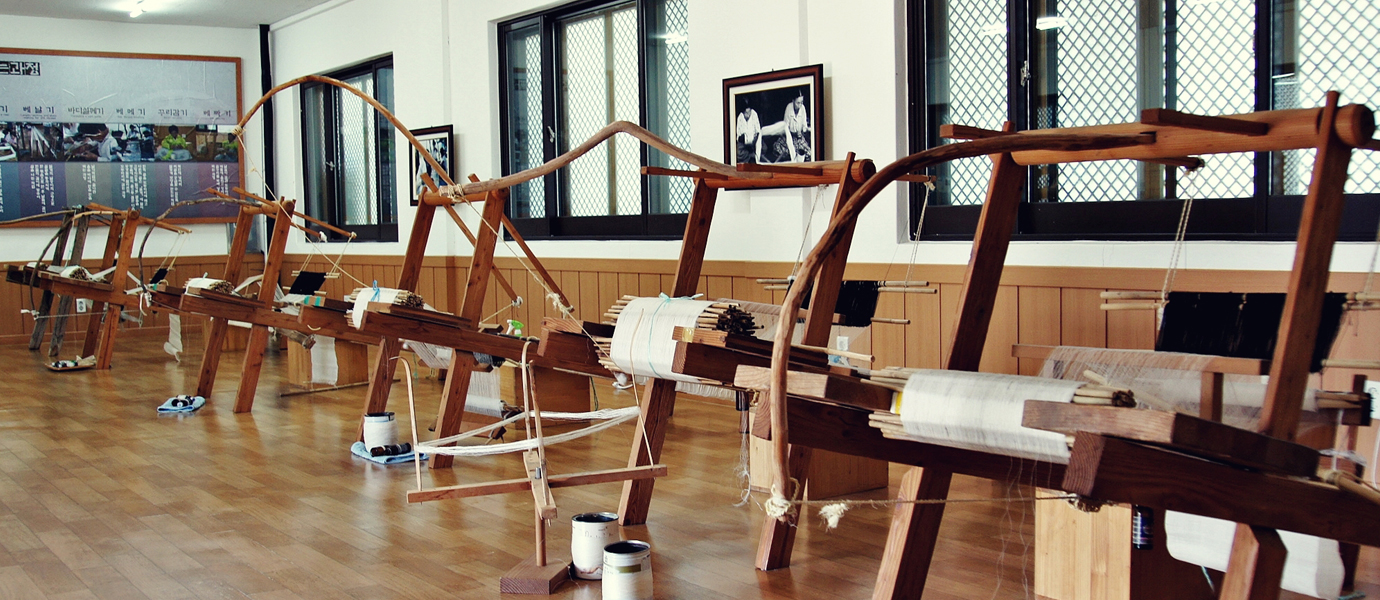
On the way to Gamsansa Temple and King Munmu's Tomb, there is the 'Dusan Silk Village', the only silk production village in the country. Nearby, a traditional silk exhibition hall was built to promote the excellence of silk, to develop the technology, and to use it as a tourism content. The exhibition hall consists of three Hanok buildings, and is used as a silk exhibition hall, silk workshop, and silk dyeing center.
Silk is a high-quality natural fiber called the 'Queen of Fibers'. It is superbly soft and wraps around the body, and is light and breathable. It is also a tough fiber that can be dyed in any color, so it is highly versatile.
The Silk Exhibition Hall offers a wealth of things to see, from the origin of the precious fabric, Sonmyeongju, to finding traces of silk in Silla history, to content recreating the process of weaving silk. In the Silk Workshop next to the exhibition hall, you can see silk craftsmen who are continuing the tradition of Sonmyeongju weaving fabric on looms. If you go during work hours, you can see the process of boiling silkworm cocoons in water to make threads, and weaving fabrics with warp and weft threads on a loom. Please note that if you inquire in advance before visiting, you will have a higher chance of seeing the precious work site.
- Gyeongju City Traditional Silk Exhibition Hall Visiting Information
- Location: 154 Myeongju-gil, Munmu-daewang-myeon, Gyeongju-si
- Opening hours: 09:30-17:00
- Admission: Free
- Closed: Every Monday, January 1st, Lunar New Year and Chuseok
- For inquiries: 054 777 3492
- Homepage: http://www.gyeongjusilk.com/
- How to get there by public transportation: Take bus no. 150 / Get off at Jungbodeul or Doosan Entrance stop (23 minutes on foot)
- Nearby tourist attractions: Gamsansa Temple Site, King Munmu's Tomb
#10Dongrimokwol Literature Museum
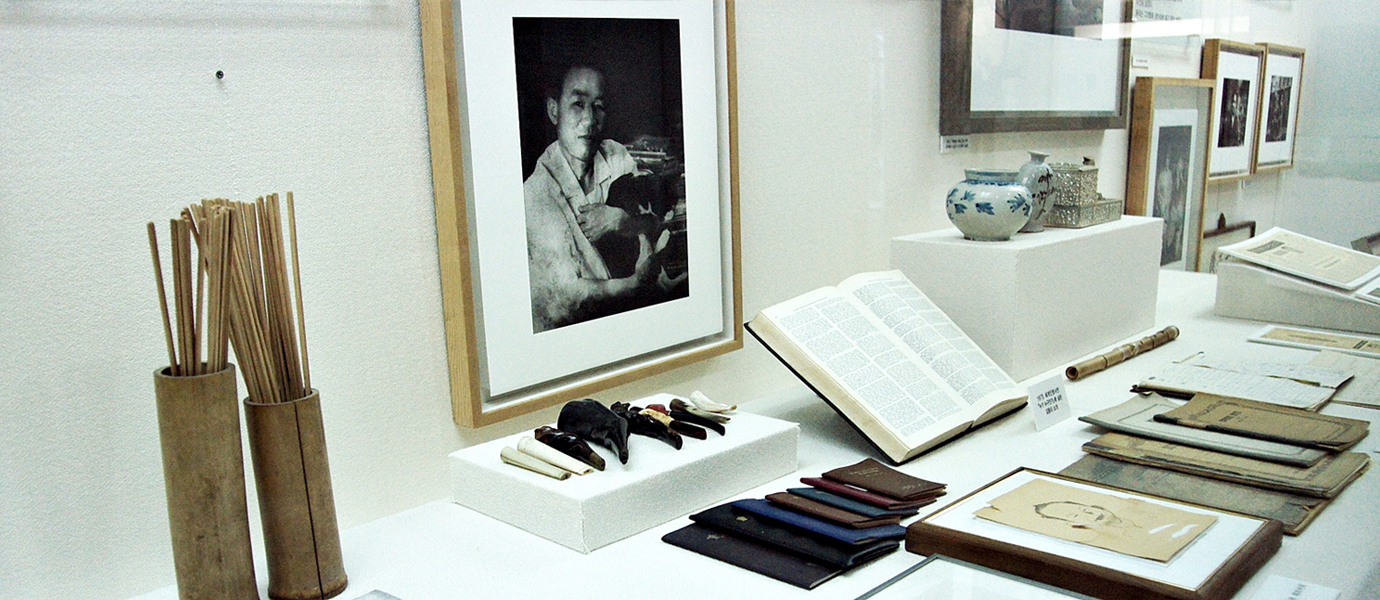
Near Bulguksa Temple, there is an exhibition hall themed on the representative Korean writers, novelist Kim Dong-ri and poet Park Mok-wol, the Dong-ri Mok-wol Literature Museum. It was built in 2006 and consists of the main building with the Dong-ri Hall and Mok-wol Hall, and the annex with the Hall of People Who Made Silla Shine. The two writers are from Gyeongju. You can meet Gyeongju in Kim Dong-ri’s outstanding works such as “Munyeodo,” “Deungsinbul,” and “Eulhwa.” The writer was a master of Korean literature who was nominated for the Nobel Prize in Literature for his long novel “Eulhwa,” which was adapted from “Munyeodo.” Park Mok-wol, a leading figure of the Cheongnokpa poets, was also born in Gyeongju, spent his childhood there, and is known to have spent most of his 20s there. He left behind beautiful works that sing of the beauty of nature and ponder the source of life. The exhibition hall recreates the study where the two writers worked during their lifetime, and introduces their world of works as rich exhibition content.
- Dongrimokwol Literature Museum Visiting Information
- Location: 406-3 Bulguk-ro, Gyeongju-si
- Opening hours: 09:00-18:00 (until 17:00 in winter)
- Closed: Every Monday, January 1st, Lunar New Year and Chuseok
- Admission: Free
- For inquiries: 054-779-6090
- Website: http://dml.gyeongju.go.kr/
- How to get there by public transportation: Take bus no. 10, 11, or 700 / Get off at Bulguksa stop (10-minute walk)
- Nearby tourist attractions: Bulguksa Temple and Seokguram Grotto
Showing posts with label Korea. Show all posts
Showing posts with label Korea. Show all posts
Gyeongju trip 10Pick [korea Tiep]
Subscribe to:
Comments (Atom)